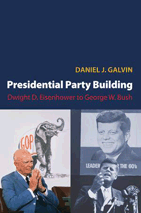The Forum
Congress and the Presidency
Choice
Election Law Journal
Political Science Quarterly
Amazon.com reviews
The Washington Monthly
Excerpts from Reviews:
"In an exceptionally well-researched and beautifully written book, Daniel Galvin...fundamentally alters our understanding of presidents' contributions to the development of political parties. Presidential Party Building will likely become a classic in the field, both for its substantive contributions and for its conceptual and analytical innovations....It will be tremendously illuminating for scholars of the presidency, party politics, American political development, and political organizations."
--Jesse H. Rhodes, The Forum
"Presidential scholars are indebted to Galvin’s seminal study not only for the new light it sheds on past presidential party building but also for the way it invites us to think afresh about the future of presidential party building… Whatever the future may hold, however, there can be no doubt that Galvin has given us the finest empirical study yet of presidential-party relations in the latter half of the twentieth century."
--Richard J. Ellis, Congress and the Presidency
"The book is an important contribution to the literature on the presidency and offers a fine research design model for qualitative social scientists. Summing Up: Highly Recommended."
--R.M. Flanagan, Choice
"By comparing and contrasting Republican and Democratic presidents, and by crisply limiting the conceptualization of party-building to strengthening the party-as-organization, Galvin presents a startling contrast between the two parties and their presidents...The spatial model and the convergence result of the median voter theorem naturally incline political scientists to assume that the major parties are inevitably organizationally symmetrical. They're not. Galvin conclusively shows that the assumption, while understandable, is false and has been false for many decades."
--Richard M. Valelly, Election Law Journal
"Daniel Galvin’s book explains in careful empirical detail the impact of post-1952 presidents upon their respective political parties. Galvin’s method involves comparative case studies based on meticulous research of reliable sources. It is an impressive summary of the actual historical record of president–party interactions."
--Steven E. Schier, Political Science Quarterly
Endorsements:
"Students of the presidency and the American party system will be grappling for years with this pathbreaking, exhaustively researched book. This is a model of the political scientist's craft, addressing an issue of major theoretical and practical significance with historical sensitivity and methodological care."
--Steven M. Teles, The Johns Hopkins University
"Galvin provides a compelling reexamination of the relationship between the modern presidency and political parties. He upends the conventional wisdom that modern presidents have systematically undermined their party organizations, demonstrating instead that minority-party presidents have played a crucial role in building the vibrant parties that occupy a central place in today's politics. Galvin combines innovative theorizing with careful archival work to develop a persuasive new perspective on the president's role in the American political system."
--Eric Schickler, University of California, Berkeley
"In this meticulously documented and gracefully written book, Dan Galvin puts presidents at the very center of party-building activities. Sometimes he finds them investing in their party, other times exploiting it. But whether they do one or the other, Galvin persuasively argues, critically depends upon their party's hold on political institutions beyond the White House. Anyone interested in the growth and decline of parties in our system of separated powers should read this important book."
--William G. Howell, University of Chicago
"This is an important book. With voluminous research and incisive analysis, it demolishes the prevailing view of how presidents relate to their political parties. Galvin forces us to rethink not only how presidents might strengthen their parties along with their own political prospects but how the two major parties have developed in so dissimilar a manner over the last half century."
--Bruce Miroff, SUNY, Albany
Back




